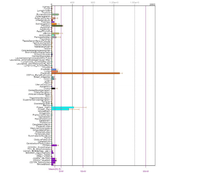FAM46A
| FAM46A | ||||||
|---|---|---|---|---|---|---|
| Identifiers | ||||||
| Aliases | FAM46A, C6orf37, XTP11, family with sequence similarity 46 member A | |||||
| External IDs | MGI: 2670964 HomoloGene: 23032 GeneCards: FAM46A | |||||
| RNA expression pattern | ||||||
 | ||||||
| More reference expression data | ||||||
| Orthologs | ||||||
| Species | Human | Mouse | ||||
| Entrez | ||||||
| Ensembl | ||||||
| UniProt |
| |||||
| RefSeq (mRNA) | ||||||
| RefSeq (protein) |
| |||||
| Location (UCSC) | Chr 6: 81.49 – 81.75 Mb | Chr 9: 85.32 – 85.33 Mb | ||||
| PubMed search | [1] | [2] | ||||
| Wikidata | ||||||
| View/Edit Human | View/Edit Mouse |
Protein FAM46A is a protein that in humans is encoded by the FAM46A gene. Aliases for Fam46A include HBV X-Transactivated Gene 11 Protein, C6orf37, and XTP11.[3] The gene contains 6 introns, and is 6982 base pairs long.[4] The transcribed mRNA is 2231 base pairs long and contains 2 exons, 589 and 1128 base pairs, with 4 alternative splice isoforms.[5]
Exon A
Expression
Expression of Fam46A is found to be exceptionally high in Placental tissue, Pineal Gland, and Pituitary Gland with low to moderate expression within Bone Marrow, Uterus, and Salivary glands.[6]

Protein
The human FAM46A protein is 461 Amino Acids long.[7]
Function
The function of Fam46A is currently unknown but there is a Variable Number Tandem Repeat in the first exon of Fam46A that has been explored within various populations and have been attempted to be linked to various retinal diseases as well as colon cancer.[8][9]
References
- ↑ "Human PubMed Reference:".
- ↑ "Mouse PubMed Reference:".
- ↑ "Fam46A (Protein Coding)". GeneCards. GeneCards. Retrieved 18 February 2015.
- ↑ "NCBI Gene". NCBI. National Center for Biotechnology Information.
- ↑ "FAM46A Ace View". AceView. NCBI. Retrieved 3 March 2015.
- ↑ "Fam46A Tissue Expression". Protein Atlas. Retrieved 13 March 2015.
- ↑ "FAM46A Ace View". AceView. NCBI. Retrieved 3 March 2015.
- ↑ Barragán, L; Borrego, S; Abd El-Aziz, MM; El-Ashry, MF; Antiñolo, G. "Genetic analysis of FAM46A in Spanish families with autosomal recessive retinitis pigmentosa: characterisation of novel VNTRs.". NCBI.
- ↑ Cui, J; Wang, W; Wang, M; Lin, J; Ma, Y; Ruan, WJ; Xu, J; Lai, MD. "[VNTR polymorphism of C6orf37 in Chinese population].". NCBI.
Further reading
- Strausberg RL, Feingold EA, Grouse LH, et al. (2003). "Generation and initial analysis of more than 15,000 full-length human and mouse cDNA sequences". Proc. Natl. Acad. Sci. U.S.A. 99 (26): 16899–903. doi:10.1073/pnas.242603899. PMC 139241
 . PMID 12477932.
. PMID 12477932. - Mungall AJ, Palmer SA, Sims SK, et al. (2003). "The DNA sequence and analysis of human chromosome 6". Nature. 425 (6960): 805–11. doi:10.1038/nature02055. PMID 14574404.
- Ota T, Suzuki Y, Nishikawa T, et al. (2004). "Complete sequencing and characterization of 21,243 full-length human cDNAs". Nat. Genet. 36 (1): 40–5. doi:10.1038/ng1285. PMID 14702039.
- Colland F, Jacq X, Trouplin V, et al. (2004). "Functional Proteomics Mapping of a Human Signaling Pathway". Genome Res. 14 (7): 1324–32. doi:10.1101/gr.2334104. PMC 442148
 . PMID 15231748.
. PMID 15231748. - Gerhard DS, Wagner L, Feingold EA, et al. (2004). "The Status, Quality, and Expansion of the NIH Full-Length cDNA Project: The Mammalian Gene Collection (MGC)". Genome Res. 14 (10B): 2121–7. doi:10.1101/gr.2596504. PMC 528928
 . PMID 15489334.
. PMID 15489334. - Rual JF, Venkatesan K, Hao T, et al. (2005). "Towards a proteome-scale map of the human protein-protein interaction network". Nature. 437 (7062): 1173–8. doi:10.1038/nature04209. PMID 16189514.
- Kimura K, Wakamatsu A, Suzuki Y, et al. (2006). "Diversification of transcriptional modulation: Large-scale identification and characterization of putative alternative promoters of human genes". Genome Res. 16 (1): 55–65. doi:10.1101/gr.4039406. PMC 1356129
 . PMID 16344560.
. PMID 16344560. - Cui J, Wang W, Lai MD, et al. (2006). "Identification of a novel VNTR polymorphism in C6orf37 and its association with colorectal cancer risk in Chinese population". Clin. Chim. Acta. 368 (1–2): 155–9. doi:10.1016/j.cca.2005.12.043. PMID 16545789.
- Lim J, Hao T, Shaw C, et al. (2006). "A protein-protein interaction network for human inherited ataxias and disorders of Purkinje cell degeneration". Cell. 125 (4): 801–14. doi:10.1016/j.cell.2006.03.032. PMID 16713569.